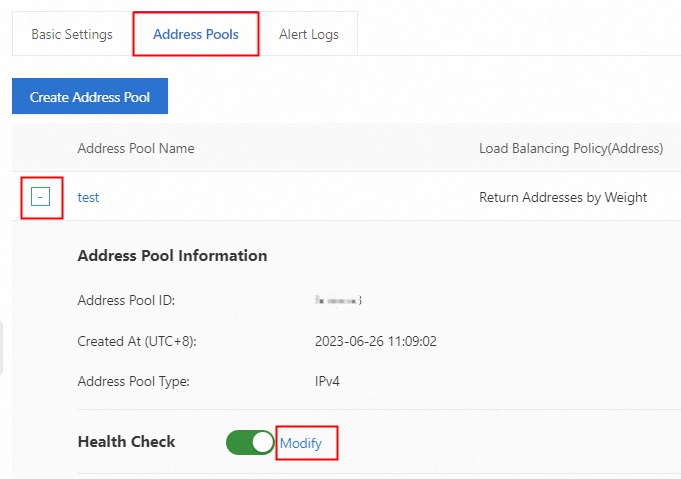A guide to performing ping-based health checks.
What is ping-based health check
A ping-based health check is a network protocol used by GTM to assess the health of destination addresses. By setting up a ping-based health check in the address pool configuration, each IP address is individually monitored to determine the operational status of the application service. If an IP address exhibits abnormal behavior, it is automatically blocked, and the block is lifted once the IP address returns to normal.
Configuration parameters
-
Check Protocol
Choose ping monitoring for the target IP address to assess network reachability, packet loss rate, and latency.
-
Check Interval
Set the time interval for ping monitoring, which by default occurs every 1 minute. The minimum interval for health checks is 15 seconds, available for Ultimate users.
-
Number of Ping Packets
Determine the number of ping packets sent during each monitoring session to calculate the network packet loss rate. The available option is 20 packets.
-
Packet Loss Rate
Calculate the packet loss rate during each monitoring session. The packet loss rate is calculated as (lost packets/number of ping packets) × 100%. An abnormal alarm is triggered when the packet loss rate reaches a predefined threshold. Available thresholds are 10%, 30%, 50%, 80%, 90%, and 100%.
-
Timeout
Measure the return time for ping packets during monitoring. A health check timeout is recorded if the return time exceeds the specified timeout. Available timeout options are 2 seconds, 3 seconds, 5 seconds, and 10 seconds.
-
Consecutive Failures
If multiple consecutive monitoring sessions are abnormal, the system deems the application service as abnormal to account for network jitter or other factors. The available options for consecutive failures are 1, 2, or 3 times.
-
1 time indicates that a single alarm detection during health check monitoring classifies the application service as abnormal.
-
2 times indicates that two consecutive alarm detections classify the application service as abnormal.
-
3 times indicates that three consecutive alarm detections classify the application service as abnormal.
ImportantIf the check address experiences a network disconnection or ICMP destination unreachable, these are not counted in the failure rate, and no alarm is generated. Please address the network issue promptly or switch to an HTTP health check task.
-
Failure Ratio
This refers to the ratio of monitoring points with abnormal health checks to the total number of monitoring points. The application service is considered abnormal when the failure ratio exceeds the set threshold. The thresholds that can be set are 20%, 50%, 80%, and 100%.
-
Monitoring Nodes
This refers to the geographical locations of the nodes that perform ping monitoring. The system provides the following default monitoring nodes:
ImportantIf all addresses in the address pool are Alibaba Cloud addresses and the blackhole filtering policy is used for fault testing, select carrier nodes for monitoring. (Reason: Blackhole filtering is an ACL policy effective on the Internet between Alibaba Cloud network and carrier network, but the traffic between Alibaba Cloud IPs mainly flows within the cloud network, reducing detection effectiveness.)
Node type
Geographical location
BGP node
Zhangjiakou, Qingdao, Hangzhou, Shanghai, Hohhot, Shenzhen, Beijing
International node
Hong Kong (China), Germany, Singapore, California, Malaysia, Japan
Carrier node
Wuhan Unicom, Dalian Unicom, Nanjing Unicom, Tianjin Unicom, Qingdao Telecom, Changsha Telecom, Xi'an Telecom, Zhengzhou Telecom, Shenzhen Mobile, Dalian Mobile, Nanjing Mobile
Configuration methods
-
Log on to the Alibaba Cloud DNS console.
-
In the left-side navigation pane, click the Global Traffic Manager menu, and then click the Configuration button in the Operation column of the destination instance.
-
If the instance has not been configured with GTM, refer to the Enable health check operation document.
-
If the instance has already been configured with GTM quick configuration, select the Address Pool Configuration tab. Click the "+" next to the created address pool to expand it. Then, click the Health Check and the Modify buttons. Based on the description of the ping monitoring feature, you can edit and modify the configuration parameters of the health check.
